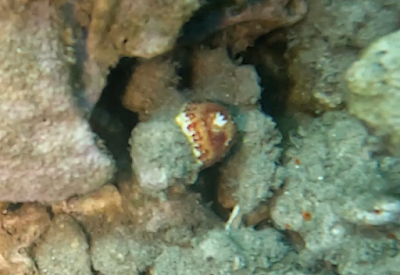All images and videos were taken by Uki, the author.
At this point, I could only export raw movie footage from today's dive.
In the future, I might edit the movie to add names of the animals and slow down some scenes. At this moment, I do not have time to do it.
Thanks to Kevin from "Maui Diving SCUBA Center" for being a great instructor and showing us creatures and their names.
Maui Diving SCUBA Center
1455 S Kihei Rd Ste 101, Kihei, HI 96753
The bigeye trevally (Caranx sexfasciatus) is a large marine fish found in the tropical waters of the Indian and Pacific Oceans. It is also known as the bigeye jack, great trevally, six-banded trevally, and dusky jack.

Trumpet fish (Aulostomus chinensis) are elongated, tube-mouthed fish commonly found in the warm waters around Hawaii. They are adept at camouflage, often aligning themselves with vertical structures and changing colors to blend in with their surroundings. This adaptation and their slender body allow them to ambush prey. Trumpet fish can grow up to about 80 cm (31 inches) in length, feeding primarily on small fish and crustaceans.
Q: How do trumpet fish hunt?
A: Trumpet fish utilize a "lie in wait" hunting strategy. They can remain almost motionless, blending in with their environment by adopting the color and shape of nearby objects, like corals or plants. When a potential prey item swims within reach, they rapidly extend their jaw to suck in the prey, a method known as suction feeding. This stealth approach and their ability to hover due to their unique swim bladder make them effective predators.
Q: Where can trumpet fish be found in Hawaii?
A: In Hawaii, trumpet fish are commonly seen in reef environments across all the main islands, including areas like Hanauma Bay on Oahu, Molokini Crater off Maui, and Kealakekua Bay on the Big Island. They prefer shallow, clear waters to easily camouflage themselves among corals, rocks, and vertical structures.
Q: Are trumpet fish endangered?
A: Trumpet fish are not currently listed as endangered or threatened. They are relatively common in their habitat range, spanning the tropical and subtropical waters of the Atlantic, Pacific, and Indian Oceans. However, like many marine species, they could be affected by habitat destruction, water pollution, and climate change, highlighting the importance of marine conservation efforts.
Q: What is the significance of trumpet fish in Hawaiian culture?
A: While not as culturally significant as some other fish in Hawaii, trumpet fish, known as "Nūnū" in Hawaiian, play a role in local marine life and are occasionally mentioned in folklore and legends. They are appreciated for their unique appearance and are occasionally caught for food. The respect for aquatic life in Hawaiian culture underscores the importance of trumpet fish and other marine species in the ecosystem.
We were going in and out of the sea caves during the dive.
The green sea turtle (Chelonia mydas) is the largest hard-shelled sea turtle, weighing up to 700 pounds and growing to 4 feet long. They are herbivores that eat algae and seagrasses, which gives their fat a greenish color. Green sea turtles are also known as black turtles or Pacific green turtles.
This big guy was resting in one of the caves.
https://www.karollewall.com/scrambled-egg-nudibranch-phyllidia-varicosa/
The banded sea urchin, also known as the double-spined urchin, is a venomous sea urchin with the scientific name Echinothrix calamari. It is found in the tropical waters of the Indo-Pacific region, from the Red Sea to French Polynesia, and can be found from the surface to 70 meters (230 ft) depth.
What SCUBA diving gear should I own?
I recommend carrying with you a couple of retractable tethers. They are inexpensive, and you will want to hook your dive computer/pressure gauge on one and your flashlight on the other.
You will need two (2) duffle bags for your gear: a personal mask, snorkel, fins, booties or socks, gloves, and maybe even a personal regulator. Why 2 duffle bags? One bigger duffle bag is made of solid fabric for airport travel. And one smaller duffle bag for the beach made of mesh; you really want all the sand and moisture to escape before you go to the hotel room or airport.
Any seasoned diver will tell you that one thing you want to own is a regulator. First, sharing a mouthpiece with people you do not know is discussed. Secondly, you want to understand how to operate your dive computer.
Finally, I added my own free-diving fin and mask set. You might want to choose shorter fins for diving, especially in tight caves. I like my long fins.
The mask has a small field of view, but it holds well on my face and makes it easy to squeeze my nose for equalizing.
Some people choose not to carry snorkel tubes for SCUBA, but I do.























No comments:
Post a Comment
Please be polite.